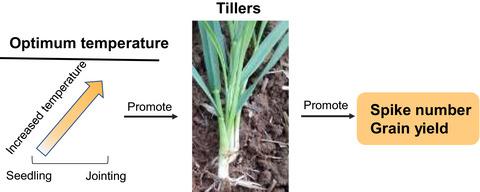当前位置:
X-MOL 学术
›
Food Energy Secur.
›
论文详情
Our official English website, www.x-mol.net, welcomes your feedback! (Note: you will need to create a separate account there.)
Impact of increased temperature on spring wheat yield in northern China
Food and Energy Security ( IF 5 ) Pub Date : 2021-04-01 , DOI: 10.1002/fes3.283 Jun Ye 1, 2 , Zhen Gao 1 , Xiaohua Wu 2 , Zhanyuan Lu 1, 2 , Cundong Li 1 , Xiaobing Wang 2 , Liyu Chen 2 , Guohui Cui 2 , Meiling Yu 2 , Guijun Yan 3 , Hui Liu 3 , Haibin Zhang 2 , Zhanxian Wang 4 , Xuefen Shi 4 , Yuanqing Li 2
Food and Energy Security ( IF 5 ) Pub Date : 2021-04-01 , DOI: 10.1002/fes3.283 Jun Ye 1, 2 , Zhen Gao 1 , Xiaohua Wu 2 , Zhanyuan Lu 1, 2 , Cundong Li 1 , Xiaobing Wang 2 , Liyu Chen 2 , Guohui Cui 2 , Meiling Yu 2 , Guijun Yan 3 , Hui Liu 3 , Haibin Zhang 2 , Zhanxian Wang 4 , Xuefen Shi 4 , Yuanqing Li 2
Affiliation

|
Global warming has been reported to cause reductions in crop yields. However, it was suggested that warming temperature might benefit crop productivity in some cool areas at high latitude. In this study, we conducted a 17‐year field experiment (2002–2018) on spring wheat in Inner Mongolia. Temperature changes during each growth stage of spring wheat were investigated. Responses of spring wheat yield to temperature changes during the specific growing stages were evaluated. Average annual maximum temperature (Tmax) and minimum temperature (Tmin) significantly increased over the past 17 years. However, Tmax did not show obvious increase trend during spring wheat growing seasons (p = 0.0672). Furthermore, Tmax also had no distinct change before or after anthesis. Tmin significantly increased during the whole growing season, as well as in pre‐ and post‐anthesis stages. Correlation analysis indicated that Tmax in the entire growing season and post‐anthesis did not affect spring wheat yield, but high Tmax during pre‐anthesis can improve grain yield. The Tmin during the life cycle and pre‐anthesis both had positive relationship with grain yield. Moreover, elevated temperature from seedling to stem elongation can benefit tiller formation and thus increasing spike number, which contributed to the significant yield increase (p = 0.0093). Overall, climate warming affect spring wheat yield in cool area, and increasing temperature that was below the optimum temperature can benefit wheat productivity.
中文翻译:

北方气温升高对春小麦产量的影响
据报道,全球变暖导致农作物减产。但是,有人建议,在某些高纬度凉爽地区,升温可能有益于作物生产力。在这项研究中,我们对内蒙古的春小麦进行了为期17年的田间试验(2002-2018年)。研究了春小麦每个生育阶段的温度变化。评估了特定生长阶段春小麦产量对温度变化的响应。在过去的17年中,年平均最高温度(T max)和最低温度(T min)显着增加。然而,在春季小麦生长季节,T max没有显示出明显的增加趋势(p = 0.0672)。此外,花前或花后的T max也没有明显变化。在整个生长期以及花前和花后阶段,T min均显着增加。相关分析表明,整个生育期和花后的T max不会影响春小麦的产量,但在花前的高T max可以提高籽粒的产量。生命周期和前花期的T min均与籽粒产量呈正相关。此外,从幼苗到茎伸长的高温可以有利于分till形成,从而增加穗数,这有助于显着提高产量(p = 0.0093)。总体而言,气候变暖会影响凉爽地区的春小麦单产,而低于最佳温度的温度升高会有利于小麦生产力。
更新日期:2021-05-12
中文翻译:

北方气温升高对春小麦产量的影响
据报道,全球变暖导致农作物减产。但是,有人建议,在某些高纬度凉爽地区,升温可能有益于作物生产力。在这项研究中,我们对内蒙古的春小麦进行了为期17年的田间试验(2002-2018年)。研究了春小麦每个生育阶段的温度变化。评估了特定生长阶段春小麦产量对温度变化的响应。在过去的17年中,年平均最高温度(T max)和最低温度(T min)显着增加。然而,在春季小麦生长季节,T max没有显示出明显的增加趋势(p = 0.0672)。此外,花前或花后的T max也没有明显变化。在整个生长期以及花前和花后阶段,T min均显着增加。相关分析表明,整个生育期和花后的T max不会影响春小麦的产量,但在花前的高T max可以提高籽粒的产量。生命周期和前花期的T min均与籽粒产量呈正相关。此外,从幼苗到茎伸长的高温可以有利于分till形成,从而增加穗数,这有助于显着提高产量(p = 0.0093)。总体而言,气候变暖会影响凉爽地区的春小麦单产,而低于最佳温度的温度升高会有利于小麦生产力。



























 京公网安备 11010802027423号
京公网安备 11010802027423号